In this article, you’ll learn What is Air compressor? Its Working, Application, Difference, and Types of Air Compressors.
You can also download the PDF file of this article at the end.
What is Air Compressor?
An air compressor, as the name indicates, is a machine to compresses the air and raises its pressure. The air compressor absorbs air from the atmosphere and compresses it. Then it sends to a storage vessel under high pressure.
From the storage vessel, it can be carried by pipeline to a location where a supply of compressed air is needed. Since air compression needs some work to be done on it, hence a compressor should be driven by some prime mover.
Compressed air is applied for various purposes such as pneumatic drills, riveters, road drills, paint spraying, starting plants, jet engines and air motors, and more.
It is also used in the operation of lifts, rams, pumps, and much other equipment. In industry, compressed air is used for producing blasts of air in blast furnaces and Bessemer converters.
Read also: List of Car Engine Parts: Its Function (Pictures) PDF
Types of Air Compressors
The following are the types of air compressors:
- Reciprocating air compressor
- Rotary air compressor
- Vane-type air compressor
- Centrifugal air compressor
- Axial air compressor
Positive Displacement Compressor
An air compressor works by drawing air into a compression chamber and reducing its volume mechanically until a set pressure is achieved. This category of compressors includes a wide range of air compressors that produce power by moving air.
The three most prevalent types of air-positive displacement compressors found in small and medium-sized industries are rotary screws, vane, and reciprocating air compressors. Although the internal workings of these air compressors differ, the basic idea remains the same.
Read Also: Understand The Different Types of Furnaces & Their Working Principle
#1 Reciprocating Air Compressor
A reciprocating air compressor is a type of positive displacement compressor that uses a piston. The piston is driven by the crankshaft to transfer the high-pressure gases into the cylinder.
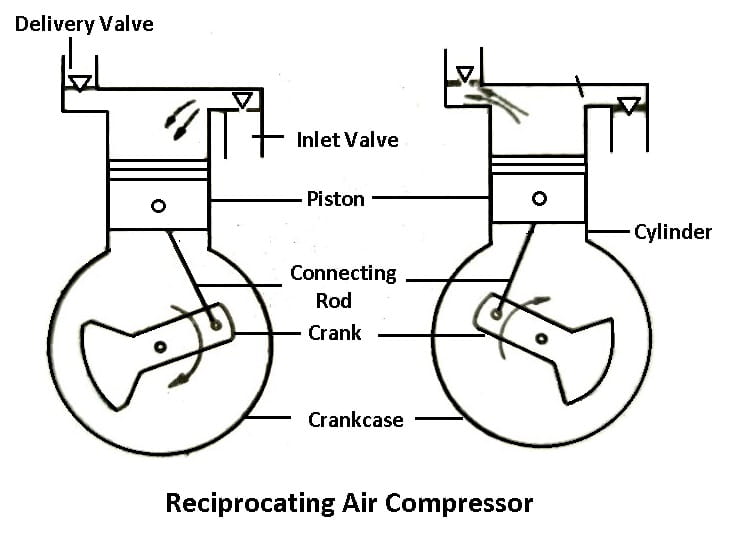
In these types of air compressors, initially, the gas enters from the suction manifold. This gas is flowing through a compression cylinder where it gets compressed by an attached piston. It is driven in a reciprocating motion by the application of a crankshaft, and it is released.
A typical reciprocating compressor is commonly used in automotive industries to generate 5 to 30 horsepower. A large type of reciprocating compressor creates up to 1000 horsepower, which equals 750 KW, and it is used in the large petroleum industry.
Compared to a regular diaphragm compressor, it has a longer lifespan and requires quiet maintenance because of continuous use. A reciprocating compressor is used in gas pipelines, chemical plants, air conditioning, and refrigeration plants.
#2 Rotary Screw Air Compressor
A rotary screw air compressor, which is the simplest compressor, consists of two rotors with lobes rotating in an air-tight casing that has an inlet and outlet ports. Its action resembles that of a gear pump.
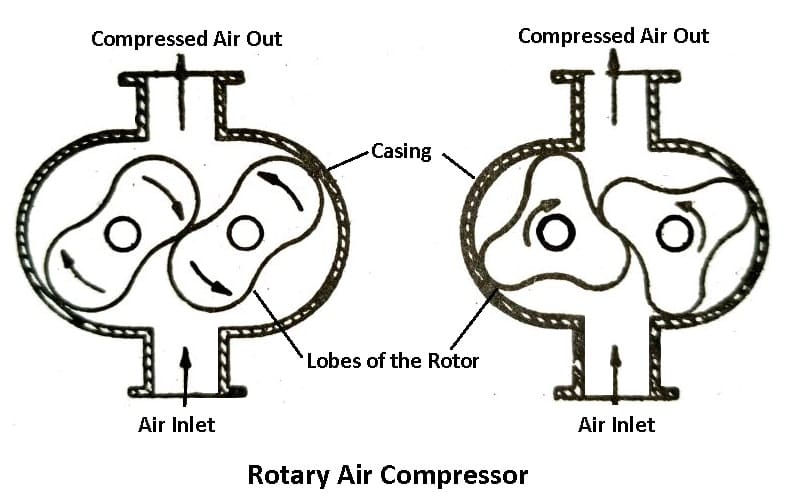
There are many designs of a wheel, but they generally have two or three lobes. The lobes are made that they provide an air-tight joint at their point of contact.
Mechanical energy is provided from one external source to one of the rotors, while the second gear is driven in advance. As the rotors rotate, the air at atmospheric pressure is trapped in the pockets formed between the lobes and casing.
The rotary motion of the lobes delivers the entered air into the receiver. Thus greater flow of air in the receiver increases its pressure. Finally, the air is delivered from the receiver at high pressure.
These air compressors are further classified into two types:
- Lubricant-injected rotary screw
- Dry-type rotary screw
#1 Lubricant-injected Rotary Screw
For a particular set of applications, the rotary screw compressor with lubricant injection is the most common type of industrial compressor. Lubricants used in lubricant-injected rotary screw compressors can be either synthetic or hydrocarbon-based.
A mixture of compressed air and injected lubricant typically exits the air end and is routed to a sump where the lubricant is removed from the compressed air. The majority of the liquid is separated using directional and speed changes.
As a result, lubricant carryover occurs in some parts per million (ppm) of the compressed air due to separating the remaining aerosols. When using two-stage compressors, the compression efficiency is increased by interstage cooling and the decreased internal losses brought on by a lower pressure across each stage.
#2 Dry-type Rotary Screw
The intermeshing rotors do not come into contact with one another in the dry type. Using externally lubricated timing gears, their relative clearances are kept within very small tolerances.
An intercooler and an aftercooler are typically used in two-stage compression designs. From 25 to 1,200 HP or 90 to 5,200 cfm, lubricant-free rotary screw compressors are available.
#3 Vane-type Air Compressor
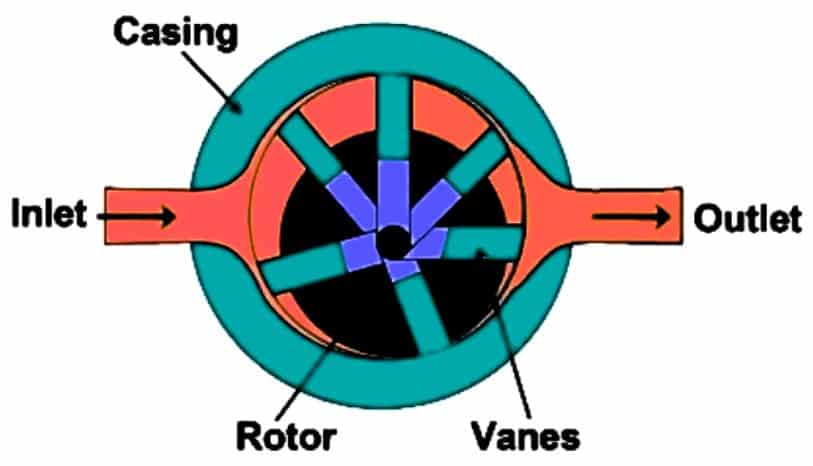
In rotary vane compressors, two openings are provided – one for suction, one for discharge – and the rotor is positioned eccentrically. An elliptical slotted rotor housed inside a cylinder is the key component of a rotary vane compressor.
Along the length of the rotor are slots, and each slot has a vane. When the compressor is spinning, centrifugal force pushes the vanes outward, and because the rotor is eccentric to the casing, the vanes move in and out of the slot.
On one side of the cylinder, the vanes pull air in; on the other, they push it out. Vane compressors are typically employed in smaller applications where floor space is a concern; however, they are less effective than rotary screw compressors.
Read Also: 12 Different Types of Heat Exchangers & Their Application [Easy Guide]
Dynamic Air Compressors
Compressors that generate pressure by converting air velocity into pressure are dynamic compressors that include rotating elements and stationary diffusers or blades that allow the air to move through the element as quickly as possible.
The compressor then stores the kinetic energy as static. In very large manufacturing facilities, dynamic air compressors, such as centrifugal and axial machines, are employed.
#4 Centrifugal Air Compressor
A centrifugal blower compressor is a common type, has a rotor (or impeller) in which several types of curved vanes are arranged symmetrically. The rotor revolves in an air-tight casing with inlet and outlet points.
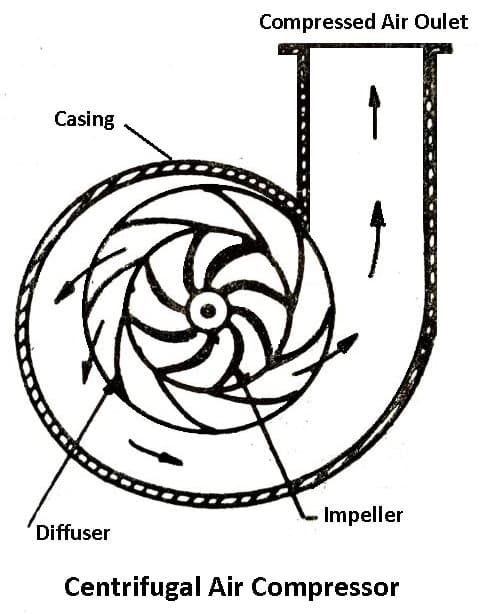
In these types of air compressors, the casing for the compressor is so designed that the kinetic energy of the air is converted into pressure energy before it leaves the casing, as shown in the figure. Mechanical energy is given to the rotor from an external source.
As the rotor rotates, it absorbs air through its eye, increases its pressure due to centrifugal force, and pushes air to flow across the diffuser. The air pressure increases further during its flow on the diffuser.
Finally, the air at high pressure is delivered to the receiver. It would remain interesting to know that air enters the impeller radially and discharge the vane axially.
#5 Axial Air Compressor
In its simplest form, an axial-flow compressor has a number of rotating blades attached to a revolving drum. The drum rotates inside an air-tight casing to which are fixed stator blade rows, as shown in the figure.
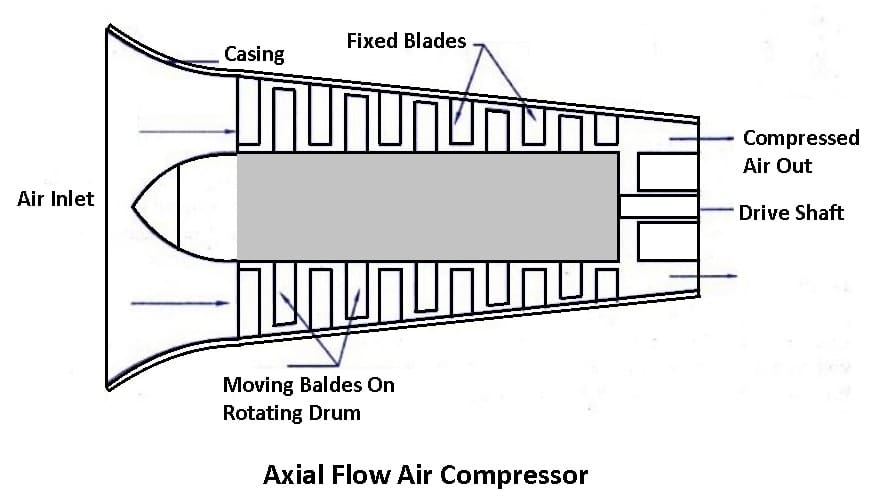
The blades are produced of an aerofoil section to lower the loss created by turbulence and boundary separation. Mechanical energy is given to the rotating shaft, which turns the drum.
The air comes from the left side of the compressor. Air flows through the arranged stator and rotor as the drum begins to rotate. As the air flows from one set of stators and rotors to another, it gets compressed.
Thus successive compression of the air, in all the sets of stator and rotor, the air is delivered at high pressure at the outlet point.
Read Also: Understand The Different Types of Electric Motors [Ful Guide]
Difference Between Reciprocating and Rotary Air Compressor
Following are the principal points of comparison of reciprocating and rotary air compressors:
| Reciprocating Air Compressor | Rotary Air Compressor |
| The greater delivery pressure can be as high as 1000 kg/cm2 in a reciprocating air compressor. | The greater delivery pressure is 10 kg/cm2 only in a rotary air compressor. |
| In this, the maximum air discharge is about 300 m3/min. | In this, the maximum air discharge is as high as 3000 m3/min. |
| They are suitable for the low discharge of air at very high pressure. | They are suitable for the large discharges of air at low pressure. |
| Speed of the air compressor is low. | Speed of the air compressor is high. |
| Air supply is intermittent. | Air supply is continuous. |
| Size of the air compressor is large for the given discharge. | Size of the air compressor is small for the given discharge. |
| The balancing is a major problem. | There is no balancing problem. |
| The air send is dirty, as it comes in contact with the lubricating oil. | The air delivered is cleaner, as it does not come in contact with the lubricating oil. |
| Lubricating system is complicated. | Lubricating system is simple. |
| In this, isothermal efficiency is applied for all sorts of calculations. | In this, isentropic efficiency is applied for all sorts of calculations. |
Difference Between Centrifugal and Axial Air Compressors
Following are the main points of comparison of the centrifugal and axial air compressors:
| Centrifugal Compressor | Axial Compressor |
| The movement of air is perpendicular to the axis of the compressor. | The movement of air is parallel to the axis of the compressor. |
| It has low manufacturing and running costs. | It has high manufacturing and running costs. |
| The centrifugal compressor requires low starting torque. | The axial compressor requires high starting torque. |
| Not suitable for multi-staging. | Suitable for multi-staging. |
| It needs a big frontal area for a given rate of flow. | It needs a small frontal area for a given rate of flow. This makes the compressor suitable for air crafts. |
Applications of Air Compressor
Air compressors used in industries such as petroleum refineries, natural gas processing plants, petrochemical, and chemical plants, and similar large industrial plants where it requires quick compressing.
It is also used in refrigeration and air conditioners to move heat in refrigerant cycles. Gas turbine systems also employ air compressors to compress the intake air in combustion.
Pneumatic tools require compressed air for many industrial, manufacturing, and construction processes. Air compressors also applied in aircraft to maintain the cabin pressure at height.
Turbochargers and superchargers are compressors that improve internal combustion engine performance by raising the mass flow of air inside the cylinder. Hence, the engine can burn more fuel, and therefore it offers more power.
Air compressor is commonly used in rail and road transport vehicles to drive the rail vehicle or road vehicle brakes.
Read Also: 13 Different Types of Coupling & Their Uses [Download PDF Now]
How to Choose Air Compressor?
If you choose an incorrect air compressor for your plant, it can cost you hundreds or thousands of dollars in lost energy and lost production time.
It is very important when selecting the right air compressor because the only factor given to the term is the cubic feet per minute of airflow required for the plant.
There are so many factors that occur when choosing a compressor for your mobile use. These factors include such as initial purchase price, ease of and cost of maintenance, size, availability, airflow, and durability are all important.
Knowing that the compressor satisfies your demands is an essential step in finalizing your industrial compressor system.
Wrapping It Up
Air compressor is a most useful machine in many industries so learning about different types of air compressor will help you understand how they work. So for now, I hope that you have learned about the different types of air compressors.
If you have any questions or doubts about this article you can ask in the comments. If you like this article then please share it with your friends.
Subscribe to our newsletter to get notified when we upload new posts. It’s Free.
Download the PDF file of this article from here:
Read More In Our Blog:
thanks
this site is very helpful to me.
I’m glad it was helpful for you. You’re welcome.
Your site is really great at presenting all the necessary information in the right way.
Thanks for your feedback.
What type of air compressor is used in medical ventilator?
In ICU ventilators, they use a gas pump compressor, which contains pressurized air and pressurized oxygen, to mix the two in the right concentration and deliver it to the patient.
Superb explanation but you should also add some content like compression ratio and volumetric ratio of compressors and efficiency also just suggest you tq sir
You’re welcome, and thanks for the suggestions. I’ll definitely update this article with more information.
Thanks for sharing… It is really a informative guide.
You’re welcome